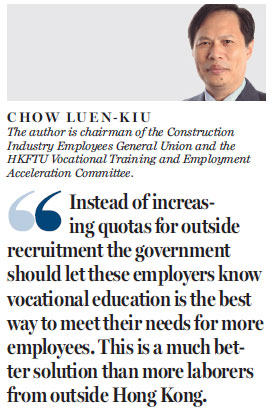Vocational training best solution to labor shortage
Updated: 2016-01-20 05:17
By CHOW Luen-kiu(HK Edition)
|
|||||||||
The 2016 Policy Address predicts that the construction industry will continue experiencing labor shortages in coming years and suggests it will need workers recruited from outside Hong Kong. Indeed, in recent years, the construction industry has not been alone in demanding workers from outside the city. The retail, restaurant and bar, electrical and machinery and elderly home services are all pressuring the government to increase labor import quotas.
However, if so many sectors truly need more qualified workers, the government should seize this opportunity to boost vocational education. This will help more young people gain upward mobility instead of blindly increasing labor recruitment from outside Hong Kong. It is a bad idea to let more overseas laborers in to take local jobs. This encourages employers to avoid investing in vocational training for our young people. It is a vicious circle that will eventually kill these sectors while reducing the job prospects of local people.
The construction industry and retail sector have adopted different approaches to vocational education. The results are interesting. The former has seen the number of workers rise in recent years whereas the retail sector has been losing employees to other industries.
The construction industry has stepped up efforts to attract young people by updating its occupational education program in recent years. In the past, most young people shunned the construction industry because they believed it was dangerous and physically demanding. But most of all, they saw no prospects for future career advancement. In order to change this perception, the industry decided a few years ago to introduce a new recruitment program. This is known as "hire and train"; employers promise trainees immediate job placements once they finish technical training. Moreover, it includes opportunities for promotion. It is unprecedented in Hong Kong and designed to show local job hunters the construction industry offers good career prospects. As a result the number of young people joining the construction industry has increased steadily and so has the number of registered construction workers.
Noting the encouraging results the construction industry achieved with its "hire and train" program, the government in 2013 put forward a similar proposal to the retail sector. This offers funding for employers experiencing a labor shortage and aims to attract young people with on-job training.
Ironically the offer was met with the cold shoulder from retailers. This is the sector who once said it needed up to 8,100 people to fill job vacancies, but it applied for fewer than 500 government-subsidized on-job training places for "interns". Even more peculiar is many employers are now publicly talking about employee redundancies. This is after the retail sector began a downward slide in the second half of last year. This suggests they may have to consider salary freezes, bonus reductions - even job cuts. It has become hard (if not impossible) to convince young people they have a solid future in the retail sector. If the retailing wants to reverse the "talent drain" of recent years then retailers must change their mindset.
This reality shows the government is obligated to ensure Hong Kong has enough young blood being trained for various industries and sectors. It is vital in sectors where employers are reluctant to take responsibility for their own future and invest in on-job training. Instead of increasing quotas for outside recruitment the government should let these employers know vocational education is the best way to meet their needs for more employees. This is a much better solution than more laborers from outside Hong Kong.

(HK Edition 01/20/2016 page9)